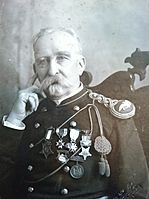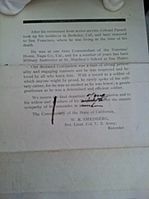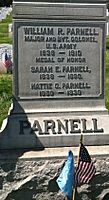William R. Parnell facts for kids
Quick facts for kids
William Russell Parnell
|
|
|---|---|

William R. Parnell
|
|
| Born | 13 August 1836 Dublin, Ireland |
| Died | 20 August 1910 (aged 74) San Francisco, California, United States |
| Place of burial | |
| Allegiance | United States of America Union |
| Service/ |
British Army United States Army |
| Years of service | 1854–1855 (British Army) 1861–1864, 1866–1887 (US Army) |
| Rank | Lieutenant Colonel Brevet Colonel |
| Unit | 1st U.S. Cavalry |
| Battles/wars | American Civil War Indian Wars Snake War Bannock Campaign Modoc War Nez Perce War Crimean War |
| Awards | Medal of Honor |
| Other work | Military instructor at Saint Matthews Episcopal Day School |
William Russell Parnell (born August 13, 1836 – died August 20, 1910) was an adventurous soldier from Ireland. He lived during the mid-to-late 1800s. He was part of the 17th Lancers during the Crimean War. He was one of the few soldiers who survived the famous and dangerous Charge of the Light Brigade.
Later, he became a Lieutenant Colonel and a temporary Colonel in the U.S. Army. He fought in the American Civil War and the Indian Wars. Parnell served as an officer with the 1st U.S. Cavalry. He was a hero in the Nez Perce War. He received the Medal of Honor for bravely leading a rescue mission. He also personally saved a fallen soldier's life at the Battle of White Bird Canyon in 1877.
Contents
William Russell Parnell's Life
Early Years and British Army Service
William Russell Parnell was born in Dublin, Ireland, on August 13, 1836. When he was 18, Parnell joined the British Army. He served with the 4th Hussars and later with the 17th Lancers. This was during the Crimean War.
He was part of the very famous and risky Charge of the Light Brigade. He was one of the few who made it out alive. He also fought in the siege of Sevastopol in 1855.
Joining the U.S. Army and Civil War
In 1860, Parnell came to the United States. He joined the U.S. Army in Brooklyn, New York, when the American Civil War started in 1861. He became part of the 4th Regiment New York Volunteer Cavalry. This group was known as "Dickel's Mounted Rifles." They mostly served with the Army of the Potomac.
During the war, he was involved in many battles. These included Cross Keys, Port Republic, Cedar Mountain, and the Second Battle of Bull Run. He also fought at Fredericksburg, Brandy Station, and Stoneman's Raid.
On June 21, 1863, he was captured at the Battle of Upperville. He was held as a prisoner-of-war for two months. He managed to escape and rejoin his regiment. He later fought in battles like the Wilderness and Spotsylvania.
Parnell was seriously wounded at Upperville. He was shot in the hip and also suffered several saber cuts. One cut damaged his nose, making it hard for him to speak clearly. He had a special metal plate made to help him talk.
Fighting in the Indian Wars
Parnell's military record was outstanding. He was wounded many times and earned promotions. After the Civil War, he joined the Regular Army. In 1866, he became a second lieutenant in the 1st U.S. Cavalry. He was promoted to first lieutenant within eight months.
In 1867, he was sent to California to fight against Native American groups. He served under Lieutenant Colonel George Crook. At the Battle of Infernal Caverns in September 1867, Parnell was wounded by an arrow. He was recognized for his bravery. He continued to fight in many campaigns in the Pacific Northwest during the 1870s. This included the Modoc War.
Medal of Honor Heroism
Parnell showed great courage during the Nez Perce War in Idaho Territory. On June 17, 1877, at the Battle of White Bird Canyon, Parnell led a small group of soldiers. They went through heavy enemy fire to rescue Sergeant Michael McCarthy and six other men. These men were defending an important position. Even though two of McCarthy's men were killed, the rest joined Parnell and kept fighting.
During the battle, Parnell went back to save a fallen soldier. This soldier's horse had been killed while crossing a marsh. Both Parnell and McCarthy received the Medal of Honor for their heroic actions.
He also fought in the Battle of the Clearwater in July 1877. He was part of the Bannock campaign in 1878. In 1879, he was promoted to captain.
Later Life and Retirement
Parnell spent several more years at military outposts in the Pacific Northwest. He retired from active service on February 11, 1887. This was due to injuries he received while on duty. In 1904, he became a major on the retirement list.
He spent his last ten years as a military instructor. He taught at Saint Matthews Episcopal Day School in San Mateo, California. William Russell Parnell died in San Francisco, California, on August 20, 1910. He passed away after falling from a street car. He was buried at the San Francisco National Cemetery.





